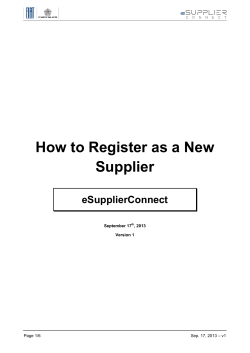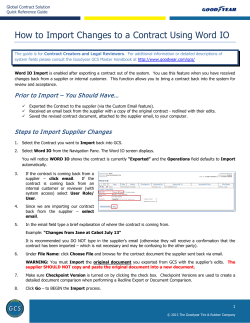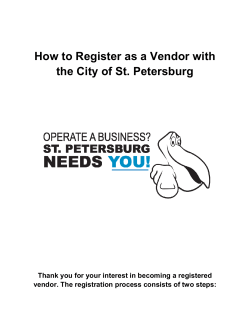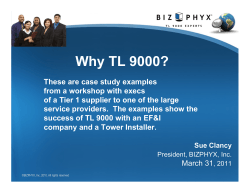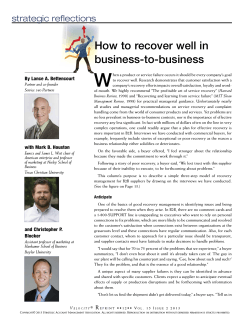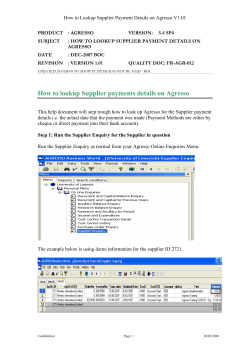
Supplier Country and Partner Country Features © Professor Daniel F. Spulber
Supplier Country and Partner Country Features © Professor Daniel F. Spulber Japan’s domestic production and exports of cars– The turning point VERs (early 80s -1995), High Yen (70s to 90s) 2 Toyota’s Activities in the US from 1957 till Today 3 Toyota’s Activities in the US in Numbers 4 Toyota’s Foreign Direct Investment in the US 5 Toyota’s Locations in the US 6 Toyota’s US-Production 7 Toyota • 1980 11 production facilities in 9 countries • 1990 20 production in 14 countries • 2003 42 production facilities in 21 countries • Production facilities in Asia, Africa, China, North America, and South America, and plans for Russia • Plans to double overseas production to 6 million vehicles WSJ, 11/2/04, p. A3 8 In June 2006, outside Japan Toyota has a total of 52 overseas manufacturing companies in 27 countries / regions. Toyota markets vehicles in more than 170 countries / regions. Source: Toyota.com 9 Supplier country features – Production and procurement Choose supplier countries for competitive advantage • Worker wages and productivity • Technology Why did Toyota choose to produce in the US in • Finance capital comparison to Japan or • Factor supplies Mexico? • Supplier industry • Political, legal, regulatory climate • Operating costs/risks 10 Supplier country features – Production and procurement Choose supplier countries for competitive advantage • Get close to customers • Can produce and procure in or near customer countries to improve distribution 11 Partner country features – Demand-side and supply-side complements Choose partners for competitive advantage • Complementary products Video game player and video games Andy Grove: “Complementors” • Complementary technology • Complementary capabilities 12 Partner countries – Demand-side and supply-side complements Choose partner countries for competitive advantage • Proximity to customer markets • Partners provide knowledge of customers • Partners provide access to human capital • Political, legal, regulatory climate important for types of agreements • Contracts, JVs, formal and informal alliances 13 Complementary technologies Television (Sony) Flat panel design (Samsung) Sony-Samsung JV: S-LCD Tang-Jeong, Korea Seventh-generation technology plant: Capacity 90,000 panels/month Eighth-generation LCD plant projected capacity 50,000 panels a month (2.2 x 2.5m) 2007 Cost: $1.9 bn Each firm will invest half. 14 Partner countries Joint venture: Tata Consultancy Services (TCS) – Microsoft TCS is India's largest IT outsourcing firm (majority partner) Microsoft – US JV to be based in Beijing, China To provide IT outsourcing services and solutions to U.S., Europe, and the Asia Pacific region, and China. Three Chinese firms are partners: Beijing Zhongguancun Software Park Development Co., Uniware Co., and Tianjin Huayuan Software Park Construction and Development Co. The Chinese firms operate national software development parks in China. 15 International modes of entry • Modes of entry are alternatives ways to produce and purchase products in supplier countries • Modes of entry are also ways to sell and distribute in a target customer country • Ownership of facilities in multiple countries makes the business a multinational corporation (MNC) • International businesses tend to be vertically integrated but this is likely to change 16 International modes of entry Options Sourcing Serving Spot (Suppliers) Buy from others Sell to others Contract (Suppliers) Repeated purchase contract Distribution contract Licenses Technical licenses to producers License brand or copyright to distributor Alliance, Joint Venture (Partners) Supply-side partner Demand-side partner/distributor Growth (Vertical integration) Establish operations Sell through own network M&A (Vertical integration) Merge with supplier Merge with distributor. 17 MIX and MATCH Modes of entry can differ: • Across supplier and partner countries • Across customer countries • Between production and distribution sides Example: GAP owns stores but outsources production 18 International modes of entry and strategy Advantages of vertical integration: Greater internal coordination across international operations Avoiding market transaction costs Internal technology transfer Avoid double marginalization 19 International modes of entry and strategy Disadvantages of vertical integration: Operating costs/risks in supplier country Less flexibility, greater organizational costs Less market responsiveness Lose benefits of focus on core competencies and outsourcing 20 Political risk • Nationalization of assets by host country (oil companies in Saudi Arabia) • Imposition of restrictions on repatriation of profits after assets have been sunk • Renegotiation of contract terms by government of host country • Changes in employment requirements, regulations, taxes, tariffs, non-tariff barriers after start of project (also public corruption) • Subsidization of domestic producers after start of project 21 Reducing political risk • Forecast potential changes in the policies of the host country – include domestic politics of host country and international relations • Understand objectives of host government – tax revenues, local control of investment, political control, employment, attracting investment, attracting technology • Understand public policy limits on market power, employment practices, environmental activities • Understand public policy differences toward international business operating abroad versus domestic business 22 Contract risk: Suppliers and partners • Renegotiation of contract terms by supplier or partner in the host country • Renegotiation of contracts by foreign suppliers and partners often protected by government policy, legal system, or absence of business reputation effects • Local supplier or partner does not honor contract (low-quality production) or defaults on payments • Supplier or partner acts after investments have been sunk – hold-up problem 23 Reducing Contract Risk • Long-term relationships with repeated exchange increase incentives for local supplier or partner to perform • Being part of a business network creates performance incentives for local supplier or partner • Use of trusted intermediaries in forming and maintaining business relationship • Evaluate legal and regulatory climate in host country 24 Trade-off between political and contract risks • Entry without local supplier or partner avoids some contract risks by going it alone – but increases political risk • Entry without local supplier or partner allows greater vertical integration and control • Sharing business with local supplier or partner reduces capital at risk and gains allies but increases contract risk • Sharing business with local supplier or partner reduces control and loses some benefits of vertical integration 25 Overview and Take-Away Points • Manager should carefully consider features of supplier countries and partner countries in production and procurement decisions • Adjust mode of entry depending on features of supplier countries and partner countries • Mode of entry is critical for global competitive advantage 26 Case study The global market for petroleum Choosing supplier and partner countries 27 Petroleum starts as a local phenomenon Gusher in Spindletop, Texas, 1902. Photo by Trost, courtesy of the Texas Energy Museum, Beaumont, Texas 28 Petroleum becomes a global market 29 Largest oil companies by production: Exxon Mobil (USA) British Petroleum Amoco (UK) Royal Dutch Shell (UK/Neth) Chevron Texaco (USA) Yukos (Russia) Total Fina Elf (France) Lukoil (Russia) ConocoPhillips (USA) Surgutneftegas (Russia) ENI (Italy) 30 International oil markets • Total proved reserves 1.025 trillion bbl (1 January 2002) • Total production 75.34 million bbl/day (2001 est.) Note: 1,025,000/75 = 13,666 days = 37 years • Oil and gas together supply 60% of world energy needs (API, 2004) • US imports over 56% of its petroleum consumption 31 Recoverable Crude Oil Futures (in billions of barrels) 0.1 Eckert VI Projection 0.1 to 1 1 to 10 10 to 20 20 to 100 > 100 U. S. Geological Survey, C. Masters & R. M. Turner 1994 World of Petroleum by C.D. Masters, D.H. Root, and R.M. Turner, World map of petroleum basins showing estimated quantities of conventional crude oil future resources in six different categories. Future quantities include identified reserves plus undiscovered resources. 33 World oil reserves 34 Extraction costs • In 1897 the first offshore oil well was drilled at the end of a wharf, 300 feet out into the ocean in Summerland , CA . • Using floating platforms, wells have been drilled in 10,000 deep water • Increasing depth as prices of oil rise http://www.eia.doe.gov/kids/energyfacts/sources/nonrenewable/offshore.html 35 World oil reserves 25 20 Cost of 15 extraction $/per barrel 10 5 0 CRUDE OIL DEEP OIL HEAVY OIL Type of oil supply 36 Oil has political dimensions that can increase costs 37 Source: American Petroleum Institute Prices adjusted for inflation (2006 = 100). 38 Source: American Petroleum Institute. Prices adjusted for inflation (2006 = 100). 39 OPEC • Eleven countries: Algeria, Indonesia, Iran, Iraq, Kuwait, Libya, Nigeria, Qatar, Saudi Arabia, the United Arab Emirates and Venezuela • Supplies about 40 per cent of the world's oil output • Has more than three-quarters of the world's total proven crude oil reserves. 40 41 42 What the future holds • Sustained higher crude prices eventually • Greater aggregate demand due to economic growth • More discoveries and more new reserves as crude prices increase • Long-term usage of petroleum • Greater efficiency due to higher prices • Many new energy alternatives and technologies coming on line 43
© Copyright 2025

